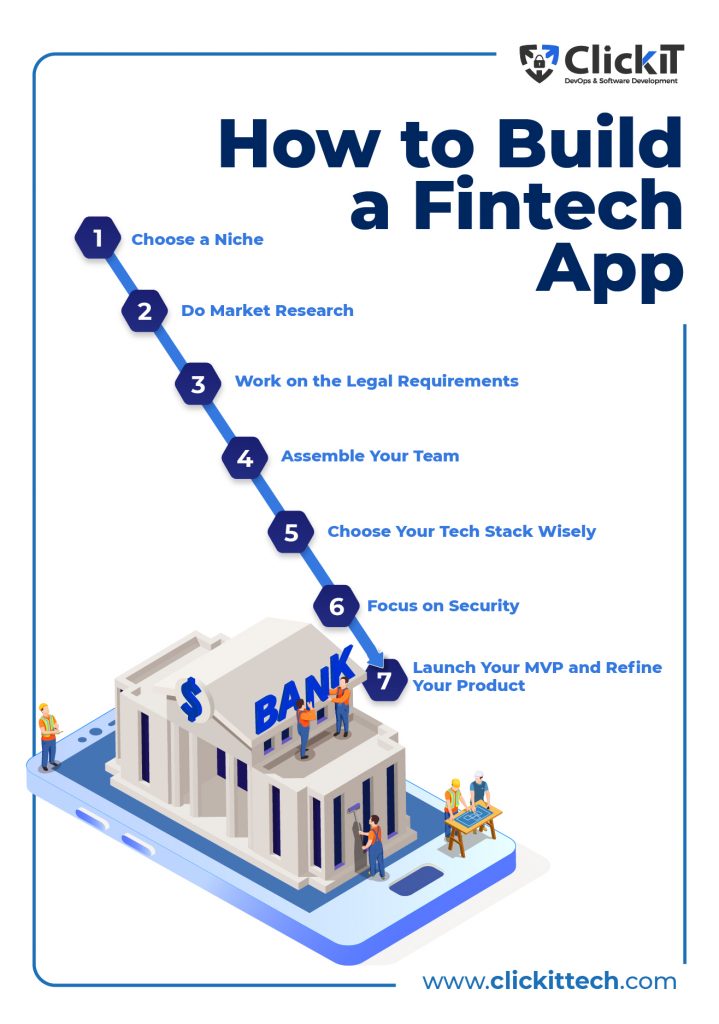There’s never been a better time than now for Fintech app development. Fintech is all the rave nowadays, and for good reasons. In Q1 2022 alone, Fintech startups raised $32.4b globally. That’s because nearly 8 in 10 people believe it’s a secure, cheaper, and faster way to manage their finances.
Many companies are approaching the industry from a different angle. There are more cutting-edge functionalities, such as Artificial Intelligence (AI) and Machine Learning (ML), to manage money and provide personalized solutions that enhance the user experience.
You can read our blog about the Top Benefits of DevOps for Financial companies to have a different approach from the angle of DevOps.
But while customers enjoy the new features, there’s more to be done. Regardless of the competition, many problems still need solutions in this ever-growing industry.
If you want to provide value and solutions to prominent financial technology-related issues, here is the ultimate guide on how to build a Fintech app.
Table of contents
- What is Fintech?
- What is Fintech App Development?
- What’s the Latest in the Fintech Industry?
- Appealing Features for Any Fintech App
- Examples of Fintech Apps
- How to Build a Fintech App?
- Conclusion
- FAQs
What is Fintech?
Fintech simply means financial technology. It is any technology or software used to perform financial and other related operations.
Financial technologies have become so prevalent that they are now a mainstay in our day-to-day activities.
Whether through ATM cash withdrawal, creating and using virtual cards on your smartphone, or mobile wire transfers to a friend in another city, you’ll find that you use fintech products often.
There’s undoubtedly a huge demand, and it’s no wonder why there are many fintech apps lately. But what exactly does it entail?
What is Fintech App Development?
A fintech app is any mobile, desktop, or web application software that provides financial services such as investment, saving, insurance, banking, and other related operations.
The Fintech industry is massive and continues to grow. Thus, there are many different fintech apps currently available in the market. However, regardless of the type of fintech software, the demand for these products has kept rising, especially in the last few years.
But don’t just take our word for it.
This overview of the fintech market will give you insights into the enormous potential that are in the industry.
What’s the Latest in the Fintech Industry?
While most industries experienced severe shutdowns in operation and growth during the pandemic, the Fintech industry witnessed a surge. Many companies were forced to provide fintech services to their customers due to the COVID-19 lockdown.
Since then, it has continued to reach new heights with a projected 25% annual growth rate. Not only did companies move to the Fintech landscape, but there was also a boom in new Fintech companies. There were around 12,200 Fintech startups in 2019, which increased to 26,000 in 2021.
And there are more to come.
According to GlobalData, fintech companies attracted $88bn in investments across 2,528 deals throughout 2021. By the end of February 2022, the fintech industry had already raised the same amount across 312 deals.
With this upward trajectory, 88% of incumbent financial institutions now believe they will lose part of their operations to standalone fintech companies in the next five years.
For example, a few years back, most people had to go to a physical financial institution to transfer funds and apply for loans and insurance. Fintech products have changed that. People can do more with less human capital.
Customers can check their credit status, make real-time payments, take mortgages and loans through Peer-to-peer (P2p) lending, request a hard credit check, and more with fintech app development.
Artificial Intelligence and Machine Learning are also shaping the delivery of Fintech products. In fact, AI is the fastest-growing technology in fintech. Apps can now provide customized user insights, help users make informed decisions about their money, and show them their spending history.
AI-powered chatbots are the digital bank clerks. With machine learning and natural language processing, these intelligent bots help customers solve issues and complete transactions faster. A chatbot’s 24/7 availability is another crucial strength that a traditional bank doesn’t have.
Beyond the benefits that artificial intelligence brings to your fintech app development, there are other features that your customers look out for.
With thousands of apps in the market, these features can help you survive the competition and stay afloat.

What are the Best Features for a Fintech App?
According to Statista, up to 75% of fintech startups fail. You don’t want that to be your company, so, when building a fintech app, it’s essential to separate the “must-haves” from the “nice-to-haves.”
Here are some of the best features:

1. A Crafted User Experience
While you may have glorious ideas of the problem you want to solve and the features your fintech app will have, it all starts with the user interface and user experience (UI/UX).
Users who find your product frustrating and annoying will not become customers. The right user experience can determine your app’s success and failure.
Here are things to put in mind to ensure the best user experience:
- Adopt a Mobile-first Design Approach, especially for a web app.
- Design an intuitive dashboard that maps out the key journeys users make.
- Personalize each user’s experience.
- Introduce self-service such as in-depth guides, FAQs, chatbots, and customer support tools to solve problems faster. It also gives users a feeling of autonomy and mastery of the app.
The ultimate goal is to provide a frictionless experience that ensures users can execute tasks easily and return in the future.
2. Friendly Security Measurements
Unsurprisingly, people are skeptical when it comes to their money. Solving a need doesn’t guarantee immediate adoption without security assurance.
Fintech apps must comply with security regulations that protect users’ financial information, especially now that cyberattacks occur every 39 seconds. As a fintech development company, here are some security measures to prevent cyber or malware attacks.
- Biometrics
Biometrics are security systems that use a person’s physical characteristics to verify their identity. This security measure is already common on modern smartphones as fingerprint mapping or facial recognition.
Password vulnerability is a prevalent cybersecurity problem that using biometrics in your app addresses.
In fact, Verizon’s 2022 Data Breach Investigation Report shows that over 80% of data breaches occur through password hacks or stolen credentials.
With biometrics, customers can perform online transactions without worrying about security concerns. Biometric systems like facial recognition also improve user experience as customers don’t need to enter their passwords whenever they want to execute a transaction.
However, while they’re almost impossible to bypass, biometrics security isn’t perfect.
Biometric systems can make two types of errors: the false accept, where the device wrongly allows an unauthorized person, and the false reject, where the device wrongly rejects an authorized person.
As such, combining biometrics with other security measures provides a more impenetrable experience.
- 2FA
Two-factor authentication (2FA) requires two different credentials.
The second credential adds an additional step to the security process, much like a double security door.
If a cybercriminal bypasses the first one, the second protects the user.
Using 2FA in your app development is a crucial feature that many potential users look forward to because it adds an extra layer of security that fortifies their funds. Duo’s 2021 State of the Auth Report shows that banking and investing is the most critical account type that people (93%) protect with 2FA.
Logging into a 2FA-protected device or account requires two things:
- Something the user already knows, such as their password.
- And a passcode is generated on a hardware device that only the user can access, such as another smartphone, a token, or a USB hardware key. However, 2FA doesn’t always require an external device anymore.
Since passwords are easily hacked, the passcode is an additional fortification because it changes frequently. Hence, it’s impossible to guess.
And a 2019 Microsoft report confirmed that 2FA could block over 99.9% of account compromise attacks.
While the chances are almost non-existent, this multi-factor authentication isn’t completely flawless. Hackers cannot bypass the security directly but can do so by
- Social engineering or phishing to trick users into disclosing their 2FA passcode
- Open Authorization (OAuth)
- Session Cookie or Man-in-the-middle
- Earlier-generated tokens
- Brute Force
- Sim-jacking
Some users may also find it inconvenient, especially when setting up another hardware device. Adopting a push notification-based 2FA can make the process easier for fintech users.
Regardless, 2FA or other multi-factor authentication remains a highly recommended security measure, especially for fintech apps.
3. Blockchain Technology
Blockchain is a decentralized ledger that can record transactions independently and anonymously without third parties. It is a reliable technology for usage in finance because of its transaction recording and transparent data transfer.
Unlike bank accounts that are centralized and managed by financial institutions, blockchain technology’s decentralized nature eliminates third-party involvement.
This speeds up transactions and makes cross-border payments cheaper, which is a boon for fintech apps that involve multiple countries.
Blockchain technology can also improve identity verification by controlling data breaches and fraudulent activities. Thus allowing fintech companies to communicate and exchange secure, unmodified data across a decentralized network.
4. Data Visualization
Numbers can be tedious for many people – it’s why not everyone reads their account statements.
Seeing charts, numbers, currencies, and large volumes of data can cause information overload and put people off. A Harvard Business Review study showed that productivity levels in people who digested information load in smaller bits were higher than in those who didn’t.
Rather than displaying bare numbers, data visualization can provide an interactive experience for users to see and monitor their transactions.
For example, high-performance technical indicators are commonly used in wealth, investment, and stock market applications to visualize and track metrics like price changes and market indexes.
Data visualization in a fintech application’s dashboard is integrated using charting controls that guide users in understanding the story behind the numbers.
The benefits are endless if done successfully. Data becomes more impactful to the user. Analytics will display more information in a small space. Hence, complex information becomes easy to interpret, and users can find new insights.
As a result, users will become more productive on the app, accountable for their finances, and make informed decisions on their spending habits.
5. Easy API Integration
An Application Programming Interface (API) is a set of functions that allow applications to communicate with each other and exchange data sources.
For example, you can use the open banking API to build a fintech app like bill.com that collects data from users’ different accounts and provides valuable insights that improve financial management.
This can also work when building a lending app such as Capital on Tap, making it easier for users or companies to get loans easily. The crediting company can use the data from mobile banks to confirm a user’s reliability in seconds and decide whether or not to provide the loan.
Mobile payment apps such as Venmo and Zelle also have easy API integrations with banking apps to help users to add and verify a bank account or debit card.
Ultimately, you want to create a seamless integration experience with minimal stress.
Also read: Fintech vs Banks

Examples of Fintech Apps
Since the financial industry is massive, it’s no surprise that there are different types of fintech apps in the market.
Here are the examples of ones that people use daily:
- Mobile Payment Apps. CashApp, PayPal, and Venmo are a few examples. Mobile payment apps are arguably the most common type of fintech apps and have features like currency conversion, virtual cards, transaction history, and analytics.
- Credit, Mortgage, and Loan Apps: Lending apps calculate your credit and mortgage and can also offer loan opportunities. They often have AI capabilities, interest calculation, Peer-to-Peer (P2P) lending, and Equated Monthly Instalments (EMI). Some examples are Rocket Mortgage, Experian Credit Report, Credit Karma, and U.S Mortgage Calculator.
- Insurance Apps: Insurance apps help users create and access insurance plans for automobiles, health, home, life, pets, and others. Some features include making payments, claim filing, and a Retirement Savings Account (RSA). GEICO Mobile, USAA SafePilot, and Esurance Mobile are some examples.
- Money Saving Apps: Personal finance apps such as Mint, Truebill Budget & Bill Tracker, and Qapital help you monitor your expenses, budget, and save for a purpose.
- Wealth and Investment Apps: These apps help you find and manage investments to grow your wealth. You can buy stocks and invest in real estate or other businesses easily. Investment apps use AI and machine learning to make personalized suggestions based on your preferences. Some examples are Stocks Alerter, VectorVest Stock Advisory, and Zillow.
- Cryptocurrency Apps: Cryptocurrency has been the new kid on the block for a long time, and with it came blockchain apps. You can create wallets, make payments, and buy and transfer cryptocurrencies using apps such as Binance and Coinbase.
- Payroll Apps: Payroll apps help companies manage, organize, and automate employee payments. The application keeps a record of every payment and stores all payment data. QuickBooks Payroll, Gusto, and ADP Workforce Now are some of the popular ones.
- Neobanks: Neobank apps are digital banks. They provide the core functionalities of the physical bank but from your smartphone. Users can receive and make payments, transfer funds, and access their account balance from anywhere. Wise, Revolut, SoFi, and GoBank are examples of neobanks. Lately, physical banks also have their mobile banks.
How to Build a Fintech App?

Step 1. Choose a Niche
The first step is deciding what subset of fintech will focus on.
This is where you decide whether your application is for personal finance, stock trading, insurance, credit, or others.
You can choose a niche and conduct market research to find what needs to be improved. Alternatively, you can generate new ideas about problems that need to be solved in the fintech industry and find a way to fit into one of the fintech categories.
Step 2. Do Market Research
After choosing your niche, it’s important to know if there is a demand for your product, the target market, their needs, and the existing competition.
This is also where you map out your plan to finalize the interface and the core features you want to offer. You’ll also need to clearly state the Minimum Viable Product (MVP) scope.
Step 3. Work on the Legal Requirements
Once you have done sound market research, it’s time to ensure that your app complies with legal requirements. Every country (and sometimes state) has different legal policies.
Some laws you should note are the ePrivacy regulation, GDPR (General Data Protection Regulation), and CCPA (California Consumer Privacy Act). Others are AML (Anti-Money Laundering), PCI DSS (Payment Card Industry Data Security Standard), and KYC (Know Your Customer), among others.
Some countries may also restrict certain features, such as blockchain technology. It’s important to clarify that your app has good legal standing, so you don’t get run out of business.
Step 4. Assemble Your Team
Now, it’s time to assemble your team.
Fintech is in a class of its own because it differs from other technologies. Recruiting the best people is one of the most critical parts of developing a professional app. Hiring seasoned engineers and programmers who have developed successful fintech software would be ideal.
You’ll need UI designers, web developers, Android developers, iOS developers, cybersecurity engineers, and DevOps.
Instead of hiring these experts individually, commissioning a well-versed agency with experience in fintech app development is one of the most preferred options.
The benefits are numerous.
First, the team has worked on previous fintech projects together, which is great for agile project management. Commissioning an agency is also cost-effective, and the project will be developed using enterprise-grade management tools. This will lead to quicker software development and delivery.
ClickIT recently partnered with DecipherCredit to develop a web-based Laravel application that makes the credit application process easier. The application has several features hosted on AWS, and key technologies such as Redis, CodeCommit, Laravel, and SQs were used.
Step 5. Choose Your Tech Stack Wisely
This step is crucial because these technologies will determine the constraints for implementing your application.
The right tech stack sets the foundation for a fintech app that is easy to maintain and scalable. You don’t want to choose the wrong programming language, platform, or third-party tool, as this can negatively affect your app’s security, performance, and scalability.
Before choosing the technologies for your app, you’ll need to consider the following:
- Security level – does the technology choice support the security level you need?
- Application’s features – what features will the fintech app have?
- Platform – Are you building a native, cross-platform, or progressive web application?
- Scalability requirements – Is the programming language scalable? Will it support user overload without affecting performance?
- Fault tolerance – Will operation continue if there is an unexpected interruption?
- Costs – How expensive are the tools and libraries? Are there cost-effective alternatives?
Answering these questions will give you a clear idea about the best technology stack for your app development. Here are some of the most-used fintech technologies you can consider.

Python: It is the most popular programming language. Python’s scalability provides developers with many use cases. For example, it can be useful in pricing, trade and risk management, and investment.
Java: Java is a popular language in the fintech industry. The Java Virtual Machine makes it simple to develop scalable, cross-platform FinTech products. Java offers the highest levels of data protection in terms of security for FinTech products. It has runtime constraints and a strong security manager. It ensures secure solutions for developing chatbots, detecting fraud, trading and investing, and using mobile wallets.
Ruby: While its popularity is dwindling, Ruby remains a simple and interactive language. It is useful for developing e-wallets, intuitive fintech dashboards, asset management, and digital payment apps.
Django: Python-powered Django is the primary framework used in fintech app development. Stock trading giant Robinhood uses it in its technology stack.
Oracle, PostgreSQL, and DB2: PostgreSQL provides great analytical capabilities, data masking, and transparent data encryption. Oracle and DB2 have amazing backup, fault tolerance, and high performance.
Artificial intelligence and machine learning are also technologies that provide a high return on investment for various applications.
Step 6. Focus on Security
Security should be a fintech app’s priority because it manages highly sensitive customer data. Integrating security in every step of your app development is of utmost importance.
A survey of more than 100 fintech startups found that 98% are vulnerable to mobile app and web attacks.
The importance of 2FA/MFA cannot be overstated, but it’s also critical to ensure infrastructural security from the backend server to the network host.
Some security measures to ensure infrastructural security are:
- Implement perimeter defense with proxy servers and firewalls. Also, ensure routers are properly configured to protect against internal attacks.
- Update operating systems and application servers regularly. You can automate this with Microsoft Software Update Service.
- Avoid installing apps or services on the server. Keep office tools, utilities, and email clients off the server.
- Start managing third-party components early.
- Employ a failover infrastructure to support the primary server and enable faster disaster recovery. High availability minimizes the chances of service interruptions and downtime. AWS cloud has become the most popular option lately. It’s a solution that can protect your app against Distributed Denial-of-Service (DDoS attacks)
Check out our blog about the top 6 AWS financial services.
Other security measures to take note of include:
- Using an SSL certificate for web apps
- Addressing security and privacy concerns during digital onboarding
- Adding a GDPR notice
- Enabling privacy control
- Encouraging stronger passwords
- 2FA/MFA
- Notifying users about third-party security, particularly if there will be API integration.
Focusing on security from the get-go will do your app and its users a world of good in the long run.
Step 7. Launch Your MVP and Refine Your Product
Now, it’s time to test your product by launching a minimum viable product (MVP). It’s important to test any app and even more critical in the financial technology industry.
Like any other app, the testing techniques for your app will be similar but more rigorous.
Quality Assurance testers will need to put the fintech app through multiple test cases in the functional, performance, database, and security testing stages to ensure you have a reliable product.
Finally, you can launch your fintech app and refine the product based on customer demands. It’s important to start with an MVP with the core functionalities before taking on more features.
Conclusion
The fintech industry has grown stupendously since the pandemic, and more growth is expected. It is now that you’ve been waiting for the right time to build a fintech app.
While challenges abound, there are numerous opportunities to solve problems and scale. However, don’t jump the gun. With these steps in building a fintech app, you can have a product that competes with the bigwigs.
Do you have a great idea? ClickIT is your best chance at realizing your fintech app. Contact our experienced team today.

FAQs
The cost of building a fintech app varies based on the features, the platform you want to build on, your location, and the technology stack. Overall, building a simple fintech app will cost between $20,000 to $50,000 or more.
A fintech ecosystem aims to create a suitable environment where various financial technology services collaborate.
Security is the primary priority of fintech apps because they manage sensitive customer data. It’s also what most customers look out for and why they are usually skeptical about new fintech products.
When we talk about fintech app development, we refer to any mobile, desktop, or web application software that provides financial services such as investment, saving, insurance, banking, and other related operations.
CashApp, PayPal, Venm, Robinhood, Acorns and Stash









